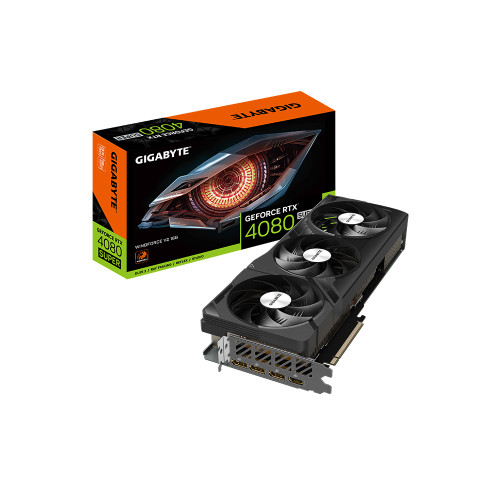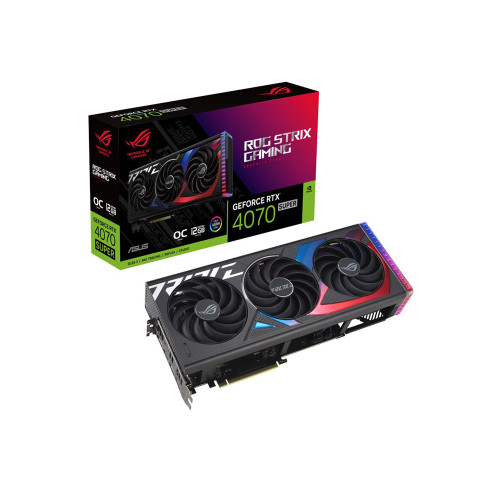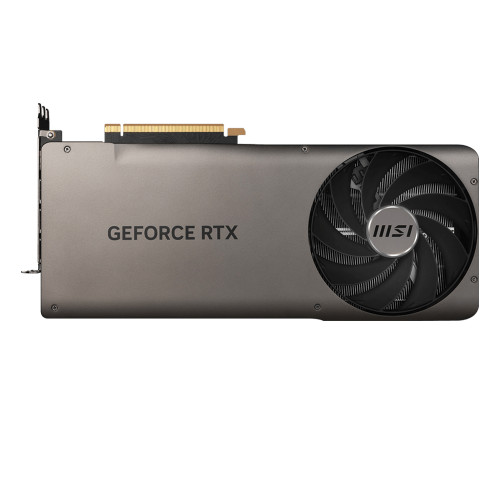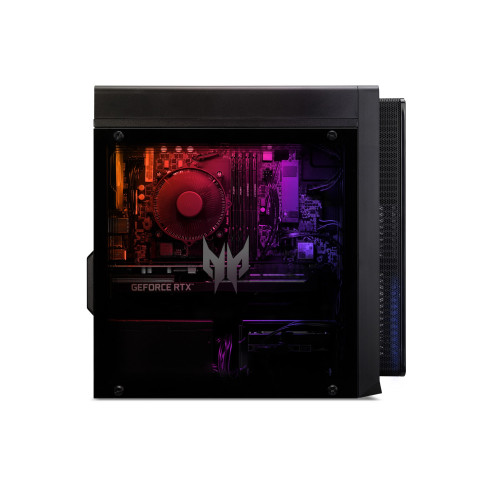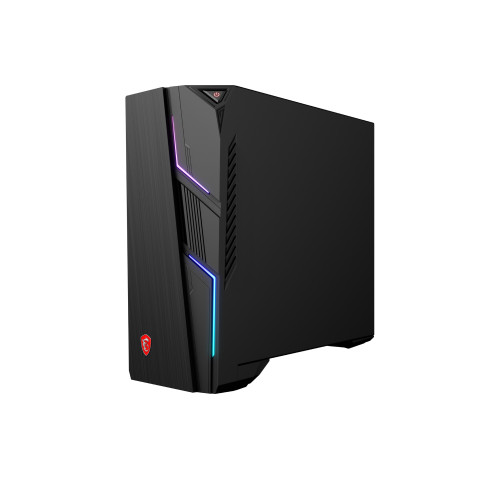POSTED: 22 October, 2024
Building a High-Performance AI Workstation with NVIDIA GPUs
Are you struggling to keep up with the demands of modern AI development?
With the rapid rise of artificial intelligence, developers are facing increasingly complex tasks that push standard hardware to its limits. Whether it's training large-scale machine learning models or working with cutting-edge generative AI, having a high-performance workstation isn't just a luxury—it's a necessity.
In today’s AI-driven world, the right hardware can make all the difference. For AI developers, speed, efficiency, and power are key, and a workstation built to handle the intense computational demands of AI tasks is essential.
As AI models become more sophisticated, so do the hardware requirements, and that's where NVIDIA GPUs come in. Known as the gold standard for AI workloads, NVIDIA AI graphics cards offer unparalleled processing power, making them an ideal choice for anyone looking to maximise their AI capabilities.
So, let’s get into the details!
Why Do You Need a High-Performance AI Workstation?
AI and machine learning are extremely demanding on hardware, far more than what standard workstations can handle. Tasks like training complex machine learning models or running AI-powered applications require significant computational power to process vast amounts of data quickly. Whether you're dealing with deep learning, neural networks, or generative AI, the sheer volume of calculations happening in the background can overwhelm regular systems. Without a high-performance workstation, you’ll likely face slower processing speeds, longer model training times, and overall inefficiency.
Why Traditional PCs Fall Short?
While many everyday tasks are easily handled by regular PCs, when it comes to AI development, integrated graphics simply can’t keep up. AI workstations demand specialised hardware to process data efficiently. You’ll quickly find that integrated graphics lead to bottlenecks, slower data processing, and lower frame rates – all of which can halt productivity in its tracks.
Integrated Graphics vs. Dedicated AI Graphics Cards
Here’s a quick comparison to help visualise the difference:
|
Feature |
Integrated Graphics |
AI Graphics Cards (NVIDIA) |
|
Performance |
Low |
High |
|
Frame Rates |
Limited |
Optimised |
|
Data Processing Speed |
Slow |
Lightning Fast |
|
AI Task Suitability |
Poor |
Exceptional |
Humans vs. Machines: Who's Got the Brainpower?
While humans rely on experience and intuition, AI models need raw computing power to learn and predict. The more complex the AI, the more powerful the hardware it needs. Invest in a high-performance AI workstation for a serious edge in the AI race.
Why are NVIDIA GPUs the Best for AI Workloads?
NVIDIA GPUs aren't just fast—they're purpose-built for AI workloads, with specialised architecture that’s fine-tuned for tasks like machine learning and generative AI. Here's a breakdown of how NVIDIA has designed their GPUs to dominate in the world of AI development:
CUDA Cores: The Foundation of Parallel Processing
At the heart of every NVIDIA GPU are CUDA cores, which are designed to handle parallel processing tasks with ease. Unlike traditional CPUs that process tasks sequentially, CUDA cores allow the GPU to process multiple tasks simultaneously. With thousands of CUDA cores in modern NVIDIA GPUs, this means faster data processing, making it ideal for the vast computations required in AI.
For Example: The NVIDIA A100 GPU boasts 6,912 CUDA cores, enabling it to handle even the most data-intensive AI tasks.
Tensor Cores: Tailor-Made for AI and Machine Learning
Beyond CUDA cores, NVIDIA’s Tensor cores are the real game-changers for AI. These cores are specifically designed for deep learning applications, allowing the GPU to perform large-scale matrix operations much faster. Tensor cores use mixed-precision computing, balancing speed and accuracy to accelerate AI tasks like neural network training.
For Example: In the A100, you’ll find 432 Tensor cores, making it a powerhouse for AI-driven computations.
Optimised for Machine Learning: FP16 and INT8 Precision
NVIDIA GPUs leverage advanced precision modes like FP16 (half-precision floating point) and INT8 (integer precision), which optimise performance without sacrificing accuracy. These precision modes allow machine learning models to run more efficiently, reducing computational load and speeding up both training and inference times.
NVIDIA’s Ampere Architecture: Powering AI Innovation
Modern NVIDIA GPUs, such as the A100, are built on the Ampere architecture, which delivers unmatched performance for AI workloads. The architecture is optimised for both data centre use and individual developers, providing scalability across a range of AI applications.
Building the Perfect High-Performance AI Workstation: Step-by-Step
If you're serious about AI development, you’ll need a workstation that can keep up with the heavy computational demands of machine learning models, generative AI, and complex datasets. Here's a step-by-step guide to help you build a powerful AI workstation, complete with the right components and optimisations.
Step 1: Choose the Right Graphics Card
NVIDIA GPUs are hands-down the best option for AI tasks. But with so many models, which one is right for you?
Quick Pick Guide for AI Graphics Cards:
|
Feature |
NVIDIA A100 |
RTX A6000 |
RTX 4090 |
NVIDIA A40 |
NVIDIA V100 |
|
CUDA Cores |
6,912 |
10,752 |
16,384 |
10,752 |
5,120 |
|
Memory |
40/80GB HBM2e |
48GB GDDR6 |
24GB GDDR6X |
48GB GDDR6 |
16/32GB HBM2 |
|
Boost Clock |
1.41 GHz |
1.41 GHz |
2.23 GHz |
1.10 GHz |
1.53 GHz |
|
FP32 TFLOPs |
19.5 |
38.7 |
82.6 |
37 |
14 |
|
Memory Bandwidth |
1.6 TB/s |
768 GB/s |
1 TB/s |
672 GB/s |
900 GB/s |
|
Best For |
Best for enterprise-level AI research. |
Perfect for professional visualisation, deep learning, and large-scale AI workloads. |
Geared towards gamers and AI developers. |
AI and machine learning in professional workstations. |
Best for scientific computing and deep learning applications. |
Whether you're focused on AI model training, large-scale data analysis, or deep learning, there's an NVIDIA GPU suited to your needs.
Step 2: Select a Processor (CPU)
Your CPU is just as important as the GPU for ensuring smooth operation. Since AI tasks require heavy multitasking between the CPU and GPU, a multi-core processor is essential.
Ideal choices: Look at processors like the Intel Core i9 or AMD Ryzen 9. These CPUs offer multiple cores and threads, ensuring efficient processing of AI workloads while balancing GPU interaction.
Step 3: Optimise RAM and Storage
AI developers dealing with machine learning models and large datasets will need plenty of RAM and fast storage. Here’s what you’ll need:
32GB+ RAM: AI models consume a lot of memory, so aim for at least 32GB of DDR4/DDR5 RAM.
1TB SSD: Go for a NVMe SSD for fast read/write speeds. This ensures quick access to large datasets and smooth operations, especially when dealing with large-scale data.
Step 4: Ensure Efficient Cooling and Power Supply
AI workstations generate a lot of heat, so an effective cooling system is crucial. Consider liquid cooling for high-end builds or high-performance air cooling to keep things cool under heavy workloads. Additionally, you'll need a strong power supply to prevent bottlenecks:
Power Supply: A 750W+ PSU should provide ample power for your setup, especially when you're running intensive AI tasks.
5 Tips for Optimising Your AI Workstation
1. Overclock Your GPU for Maximum Performance
Boost your NVIDIA graphics card's performance by overclocking it. Use NVIDIA's built-in tools to adjust clock speeds and manage power usage safely, ensuring your GPU runs at its best without overheating.
2. Tune Your AI Workstation for Productivity
Deciding between NVIDIA Studio Drivers and Game Ready Drivers? For AI development, the Studio Drivers are often the better choice, as they’re optimised for creative applications and offer stability. However, if you also game, consider dual setups to switch drivers based on your needs.
3. Maximise Frame Rates
Fine-tune your settings to achieve the best frame rates for both gaming and AI tasks. Lowering graphical settings in games can free up GPU power for AI processes, allowing you to multitask more efficiently.
4. Pro Tip: Cooling Matters!
Keep your workstation cool, especially during lengthy AI computations. Consider liquid cooling options, which can significantly improve heat management and overall performance, allowing your GPU to maintain optimal speeds for extended periods.
5. Regular Maintenance
Don’t forget to regularly clean your workstation’s components and check for software updates. Dust can accumulate and affect airflow, while updates can enhance performance and security, ensuring your workstation runs smoothly.
Building AI Workstation for Dual Use: AI & Gaming
Your AI Workstation Be a Gaming PC Too! Thanks to NVIDIA's superior frame generation and AI-powered enhancements, your AI workstation can easily double as a gaming rig. Not only can it handle AI workloads, but it also delivers top-notch gaming performance with enhanced graphics and improved frame rates. This is great for AI developers who also enjoy gaming in their downtime.
Recommended Setup for AI & Gaming:
NVIDIA RTX 4080/4090: This GPU is a powerhouse for both AI tasks and high-performance gaming, offering fantastic frame generation and smooth gameplay.
Balanced CPU & RAM: To make the most of both AI tasks and gaming, ensure your CPU and RAM are optimised for multitasking, such as the Intel Core i9 paired with 32GB of RAM.
NVIDIA Studio Drivers Vs. Game Ready Drivers
When using an NVIDIA GPU, the type of drivers you choose can significantly impact your system’s performance, whether for gaming or AI tasks.
NVIDIA Studio Drivers
- Optimised for Creators: These drivers are tailored for creative professionals and AI developers. They enhance performance and stability for applications commonly used in video editing, 3D rendering, and AI model training.
- Stability and Compatibility: Studio drivers undergo rigorous testing to ensure compatibility with software like TensorFlow, Adobe Creative Suite, and other AI-focused tools, providing a more reliable experience for intensive workloads.
- Performance Benefits: Users can expect improved performance in tasks that require extensive calculations, such as training deep learning models or rendering complex graphics, making them ideal for AI workstations.
Game Ready Drivers
- Tailored for Gaming: Game Ready Drivers are designed specifically for the latest games, ensuring the best possible performance and experience right at launch. They are continuously updated to optimise gameplay and fix bugs associated with new titles.
- Focus on Frame Rates: These drivers are tweaked to maximise frame rates and visual fidelity, providing gamers with the smoothest gameplay and best graphics possible.
- Quick Updates: NVIDIA frequently releases updates to these drivers, ensuring that gamers have the latest optimisations and features to enjoy their games.
Best Graphics Cards Available at Box for AI Workstations
If you're building a high-performance AI workstation, the right graphics card can make all the difference. Below are some top picks available at Box.co.uk, perfect for elevating your AI projects:
GIGABYTE GeForce RTX 4080 Graphics Card
With 16GB of memory and the latest Ada Lovelace architecture, this card is a powerhouse for handling complex AI models, data processing, and deep learning tasks. Its performance is designed to excel in both AI development and high-end gaming, offering incredible speed and efficiency.
|
Pros |
Cons |
|
- Powerful 16GB memory |
- High price |
|
- Ada Lovelace architecture for AI efficiency |
- Overkill for smaller AI projects |
|
- Advanced cooling system for sustained performance |
|
ASUS GeForce RTX 4070 Graphics Card
Equipped with 12GB of memory, this card strikes a perfect balance between AI development and gaming. It’s known for its durability and efficient thermal management, making it ideal for long hours of AI training, simulations, and game rendering. Its robust performance ensures smooth multitasking.
|
Pros |
Cons |
|
- Excellent value for performance |
- Not ideal for very large-scale AI projects |
|
- Durable build with reliable thermal design |
- Lower power than the 4080 series |
|
- Great for both AI tasks and gaming |
|
MSI GeForce RTX 4080 Graphics Card
This slim and sleek card combines 16GB memory with advanced cooling technology to keep temperatures in check during intensive AI model training. It’s built for high-performance tasks, including generative AI, offering both power and efficiency in a more compact design.
|
Pros |
Cons |
|
- Slim, space-saving design |
- High price |
|
- 16GB memory for handling complex AI tasks |
- Limited availability |
|
- Quiet and efficient cooling for intensive workloads |
|
Acer Predator PO3-650
A complete tower desktop, this machine is powered by an Intel Core i7, 16GB of RAM, and the NVIDIA RTX 4070 graphics card. It’s a versatile system built for both AI workloads and gaming, with ample storage space from its 2TB HDD + 1TB SSD configuration, making it a fantastic all-rounder for performance-heavy tasks.
|
Pros |
Cons |
|
- All-in-one setup, no assembly required |
- Slower HDD performance |
|
- Large storage (2TB HDD + 1TB SSD) |
- Less upgrade potential than custom builds |
|
- Great for both AI tasks and gaming |
|
MSI MAG Codex 6
Designed for high-end computing, this setup features an Intel Core i7, 16GB of RAM, and an NVIDIA RTX 4060 GPU. It’s well-suited for AI projects that require multi-tasking and performance consistency, while also delivering great gaming experiences when needed.
|
Pros |
Cons |
|
- Affordable price |
- Less powerful compared to RTX 4070/4080 |
|
- Solid multitasking capabilities for AI and gaming |
- Lower storage compared to other models |
|
- Suitable for entry-level AI work |
|
Where to Buy AI Graphics Cards and AI Workstations?
To buy AI graphics cards and AI Workstation, Box.co.uk is a top destination. We offer a wide selection of graphics cards, laptops, and AI desktop PCs from multiple top brands. Whether you're looking for powerful NVIDIA GPUs, high-performance laptops, or AI-optimised desktop setups, we have everything you need for high-end functionality and seamless AI computing.
Conclusion: Build Your AI Dream Machine Today
In conclusion, building a high-performance AI workstation with NVIDIA GPUs is essential for keeping pace in the rapidly evolving world of AI and machine learning. With the right hardware, particularly graphics cards for AI, you can unlock your full potential and take on ambitious projects with confidence.
Ready to get started? Explore your options for AI graphics cards and NVIDIA AI PCs at Box.co.uk today and take the first step towards building your high-performance AI rig! Your future in AI awaits!
